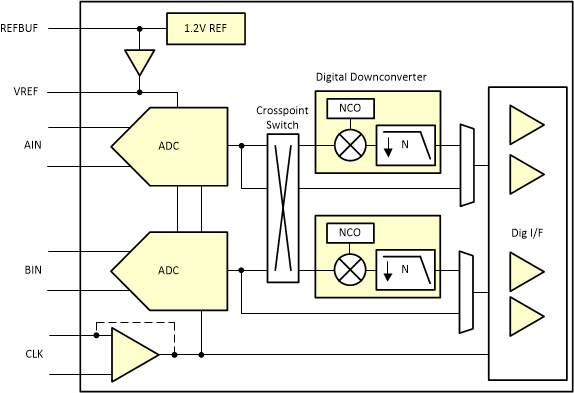SBAS886A October 2020 – May 2022 ADC3641 , ADC3642 , ADC3643
PRODUCTION DATA
- 1 Features
- 2 Applications
- 3 Description
- 4 Revision History
- 5 Pin Configuration and Functions
-
6 Specifications
- 6.1 Absolute Maximum Ratings
- 6.2 ESD Ratings
- 6.3 Recommended Operating Conditions
- 6.4 Thermal Information
- 6.5 Electrical Characteristics - Power Consumption
- 6.6 Electrical Characteristics - DC Specifications
- 6.7 Electrical Characteristics - AC Specifications ADC3641
- 6.8 Electrical Characteristics - AC Specifications ADC3642
- 6.9 Electrical Characteristics - AC Specifications ADC3643
- 6.10 Timing Requirements
- 6.11 Typical Characteristics - ADC3641
- 6.12 Typical Characteristics - ADC3642
- 6.13 Typical Characteristics - ADC3643
- 7 Parameter Measurement Information
- 8 Detailed Description
- 9 Application and Implementation
- 10Device and Documentation Support
- 11Mechanical, Packaging, and Orderable Information
Package Options
Mechanical Data (Package|Pins)
- RSB|40
Thermal pad, mechanical data (Package|Pins)
- RSB|40
Orderable Information
8.4.2 Power Down Options
A global power down mode can be enabled via SPI as well as using the power down pin (PDN/SYNC). There is an internal pull-down 21 kΩ resistor on the PDN/SYNC input pin and the pin is active high - so the pin needs to be pulled high externally to enter global power down mode.
The SPI register map provides the capability to enable/disable individual blocks directly or via PDN pin mask in order to trade off power consumption vs wake up time as shown in Table 8-11.
 Figure 8-49 Power Down Configurations
Figure 8-49 Power Down ConfigurationsTable 8-11 Overview of Power Down Options
| Function/ Register | PDN via SPI | Mask for Global PDN | Feature - Default | Power Impact | Wake-up time | Comment |
|---|---|---|---|---|---|---|
| ADC | Yes | - | Enabled | Both ADC channels are included in Global PDN automatically | ||
| Reference gain amplifier | Yes | Yes | Enabled | ~ 0.4 mA | ~3 us | Should only be powered down in power down state. |
| Internal 1.2 V reference | Yes | External ref | ~ 1-3.5 mA | ~3 ms | Internal/external reference selection is available through SPI and REFBUF pin. | |
| Clock buffer | Yes | Differential clock | ~ 1 mA | n/a | Single ended clock input saves ~ 1mA compared to differential. Some programmability is available through the REFBUF pin. | |
| Output interface drivers | Yes | - | Enabled | varies | n/a | Depending on output interface mode, unused output drivers can be powered down for maximum power savings |
| Decimation filter | Yes | - | Disabled | see electrical table | n/a |